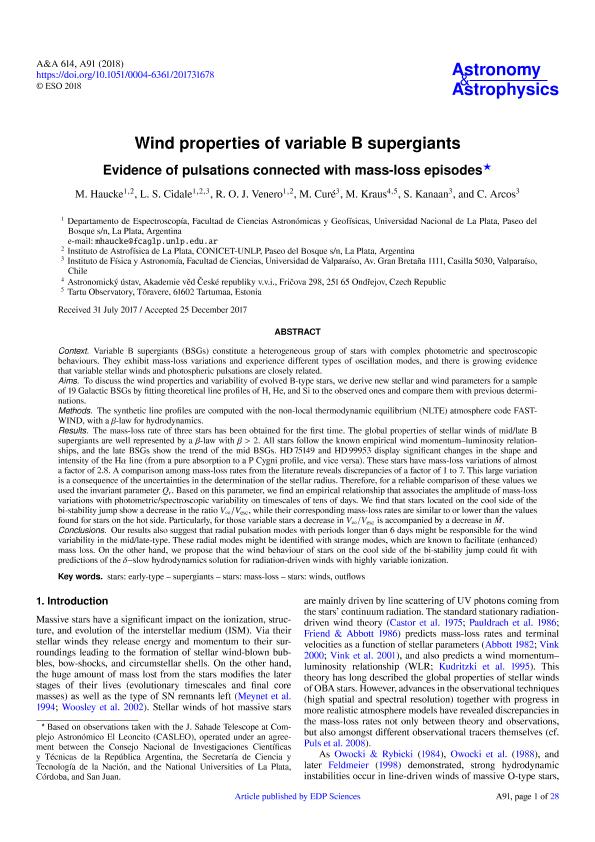Artículo
Wind properties of variable B supergiants. Evidence of pulsations connected with mass-loss episodes
Haucke, Maximiliano ; Cidale, Lydia Sonia
; Cidale, Lydia Sonia ; Venero, Roberto Oscar José
; Venero, Roberto Oscar José ; Curé, M.; Kraus, M.; Kanaan, S.; Arcos, C.
; Curé, M.; Kraus, M.; Kanaan, S.; Arcos, C.
 ; Cidale, Lydia Sonia
; Cidale, Lydia Sonia ; Venero, Roberto Oscar José
; Venero, Roberto Oscar José ; Curé, M.; Kraus, M.; Kanaan, S.; Arcos, C.
; Curé, M.; Kraus, M.; Kanaan, S.; Arcos, C.
Fecha de publicación:
06/2018
Editorial:
EDP Sciences
Revista:
Astronomy and Astrophysics
ISSN:
0004-6361
Idioma:
Inglés
Tipo de recurso:
Artículo publicado
Clasificación temática:
Resumen
Context. Variable B supergiants (BSGs) constitute a heterogeneous group of stars with complex photometric and spectroscopic behaviours. They exhibit mass-loss variations and experience different types of oscillation modes, and there is growing evidence that variable stellar winds and photospheric pulsations are closely related. Aims: To discuss the wind properties and variability of evolved B-type stars, we derive new stellar and wind parameters for a sample of 19 Galactic BSGs by fitting theoretical line profiles of H, He, and Si to the observed ones and compare them with previous determinations. Methods: The synthetic line profiles are computed with the non-local thermodynamic equilibrium (NLTE) atmosphere code FASTWIND, with a β-law for hydrodynamics. Results: The mass-loss rate of three stars has been obtained for the first time. The global properties of stellar winds of mid/late B supergiants are well represented by a β-law with β > 2. All stars follow the known empirical wind momentum-luminosity relationships, and the late BSGs show the trend of the mid BSGs. HD 75149 and HD 99953 display significant changes in the shape and intensity of the Hα line (from a pure absorption to a P Cygni profile, and vice versa). These stars have mass-loss variations of almost a factor of 2.8. A comparison among mass-loss rates from the literature reveals discrepancies of a factor of 1 to 7. This large variation is a consequence of the uncertainties in the determination of the stellar radius. Therefore, for a reliable comparison of these values we used the invariant parameter Qr. Based on this parameter, we find an empirical relationship that associates the amplitude of mass-loss variations with photometric/spectroscopic variability on timescales of tens of days. We find that stars located on the cool side of the bi-stability jump show a decrease in the ratio V∞/Vesc, while their corresponding mass-loss rates are similar to or lower than the values found for stars on the hot side. Particularly, for those variable stars a decrease in V∞/Vesc is accompanied by a decrease in Ṁ. Conclusions: Our results also suggest that radial pulsation modes with periods longer than 6 days might be responsible for the wind variability in the mid/late-type. These radial modes might be identified with strange modes, which are known to facilitate (enhanced) mass loss. On the other hand, we propose that the wind behaviour of stars on the cool side of the bi-stability jump could fit with predictions of the δ-slow hydrodynamics solution for radiation-driven winds with highly variable ionization.Based on observations taken with the J. Sahade Telescope at Complejo Astronómico El Leoncito (CASLEO), operated under an agreement between the Consejo Nacional de Investigaciones Científicas y Técnicas de la República Argentina, the Secretaría de Ciencia y Tecnología de la Nación, and the National Universities of La Plata, Córdoba, and San Juan.
Palabras clave:
Stars: early-type
,
Supergiants
,
Stars: mass-loss
,
Stars: winds, outflows
Archivos asociados
Licencia
Identificadores
Colecciones
Articulos(IALP)
Articulos de INST.DE ASTROFISICA LA PLATA
Articulos de INST.DE ASTROFISICA LA PLATA
Citación
Haucke, Maximiliano; Cidale, Lydia Sonia; Venero, Roberto Oscar José; Curé, M.; Kraus, M.; et al.; Wind properties of variable B supergiants. Evidence of pulsations connected with mass-loss episodes; EDP Sciences; Astronomy and Astrophysics; 614; 6-2018; 1-28
Compartir
Altmétricas



